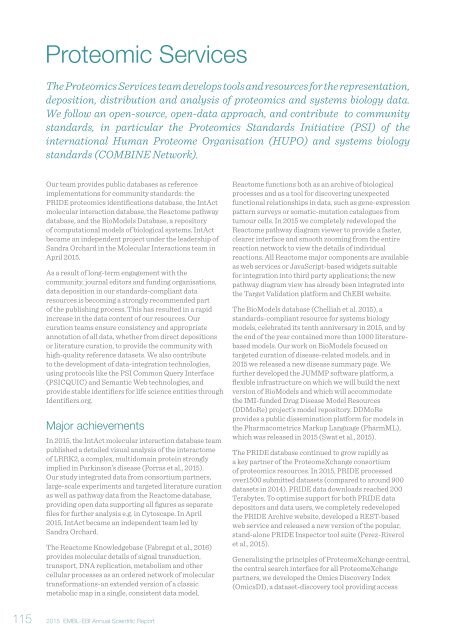Annual Scientific Report 2015
EMBL_EBI_ASR_2015_DigitalEdition
EMBL_EBI_ASR_2015_DigitalEdition
Create successful ePaper yourself
Turn your PDF publications into a flip-book with our unique Google optimized e-Paper software.
Proteomic Services<br />
The Proteomics Services team develops tools and resources for the representation,<br />
deposition, distribution and analysis of proteomics and systems biology data.<br />
We follow an open-source, open-data approach, and contribute to community<br />
standards, in particular the Proteomics Standards Initiative (PSI) of the<br />
international Human Proteome Organisation (HUPO) and systems biology<br />
standards (COMBINE Network).<br />
Our team provides public databases as reference<br />
implementations for community standards: the<br />
PRIDE proteomics identifications database, the IntAct<br />
molecular interaction database, the Reactome pathway<br />
database, and the BioModels Database, a repository<br />
of computational models of biological systems. IntAct<br />
became an independent project under the leadership of<br />
Sandra Orchard in the Molecular Interactions team in<br />
April <strong>2015</strong>.<br />
As a result of long-term engagement with the<br />
community, journal editors and funding organisations,<br />
data deposition in our standards-compliant data<br />
resources is becoming a strongly recommended part<br />
of the publishing process. This has resulted in a rapid<br />
increase in the data content of our resources. Our<br />
curation teams ensure consistency and appropriate<br />
annotation of all data, whether from direct depositions<br />
or literature curation, to provide the community with<br />
high-quality reference datasets. We also contribute<br />
to the development of data-integration technologies,<br />
using protocols like the PSI Common Query Interface<br />
(PSICQUIC) and Semantic Web technologies, and<br />
provide stable identifiers for life science entities through<br />
Identifiers.org.<br />
Major achievements<br />
In <strong>2015</strong>, the IntAct molecular interaction database team<br />
published a detailed visual analysis of the interactome<br />
of LRRK2, a complex, multidomain protein strongly<br />
implied in Parkinson’s disease (Porras et al., <strong>2015</strong>).<br />
Our study integrated data from consortium partners,<br />
large-scale experiments and targeted literature curation<br />
as well as pathway data from the Reactome database,<br />
providing open data supporting all figures as separate<br />
files for further analysis e.g. in Cytoscape. In April<br />
<strong>2015</strong>, IntAct became an independent team led by<br />
Sandra Orchard.<br />
The Reactome Knowledgebase (Fabregat et al., 2016)<br />
provides molecular details of signal transduction,<br />
transport, DNA replication, metabolism and other<br />
cellular processes as an ordered network of molecular<br />
transformations-an extended version of a classic<br />
metabolic map in a single, consistent data model.<br />
Reactome functions both as an archive of biological<br />
processes and as a tool for discovering unexpected<br />
functional relationships in data, such as gene-expression<br />
pattern surveys or somatic-mutation catalogues from<br />
tumour cells. In <strong>2015</strong> we completely redeveloped the<br />
Reactome pathway diagram viewer to provide a faster,<br />
clearer interface and smooth zooming from the entire<br />
reaction network to view the details of individual<br />
reactions. All Reactome major components are available<br />
as web services or JavaScript-based widgets suitable<br />
for integration into third party applications; the new<br />
pathway diagram view has already been integrated into<br />
the Target Validation platform and ChEBI website.<br />
The BioModels database (Chelliah et al. <strong>2015</strong>), a<br />
standards-compliant resource for systems biology<br />
models, celebrated its tenth anniversary in <strong>2015</strong>, and by<br />
the end of the year contained more than 1000 literaturebased<br />
models. Our work on BioModels focused on<br />
targeted curation of disease-related models, and in<br />
<strong>2015</strong> we released a new disease summary page. We<br />
further developed the JUMMP software platform, a<br />
flexible infrastructure on which we will build the next<br />
version of BioModels and which will accommodate<br />
the IMI-funded Drug Disease Model Resources<br />
(DDMoRe) project’s model repository. DDMoRe<br />
provides a public dissemination platform for models in<br />
the Pharmacometrics Markup Language (PharmML),<br />
which was released in <strong>2015</strong> (Swat et al., <strong>2015</strong>).<br />
The PRIDE database continued to grow rapidly as<br />
a key partner of the ProteomeXchange consortium<br />
of proteomics resources. In <strong>2015</strong>, PRIDE processed<br />
over1500 submitted datasets (compared to around 900<br />
datasets in 2014). PRIDE data downloads reached 200<br />
Terabytes. To optimise support for both PRIDE data<br />
depositors and data users, we completely redeveloped<br />
the PRIDE Archive website, developed a REST-based<br />
web service and released a new version of the popular,<br />
stand-alone PRIDE Inspector tool suite (Perez-Riverol<br />
et al., <strong>2015</strong>).<br />
Generalising the principles of ProteomeXchange central,<br />
the central search interface for all ProteomeXchange<br />
partners, we developed the Omics Discovery Index<br />
(OmicsDI), a dataset-discovery tool providing access<br />
115<br />
<strong>2015</strong> EMBL-EBI <strong>Annual</strong> <strong>Scientific</strong> <strong>Report</strong>


